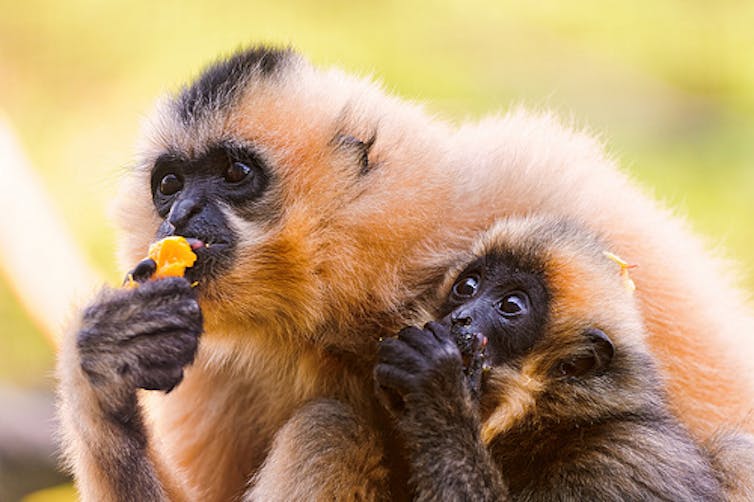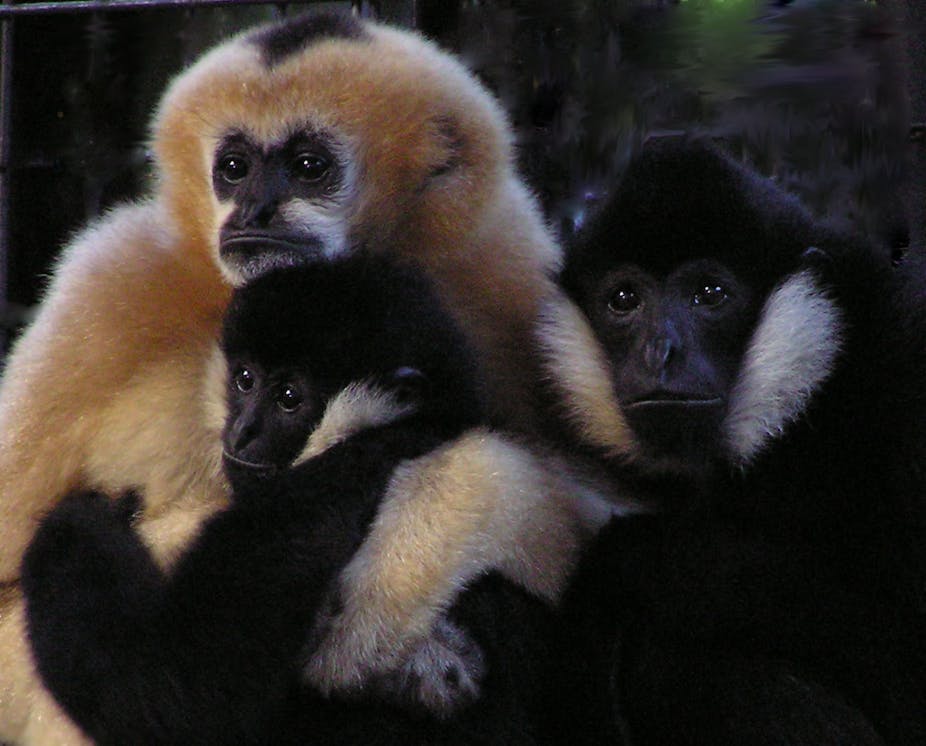Gibbons are among our closest living relatives. These small apes are beautiful singers and glorious swingers. But a new survey of their numbers has found an economic boom in Vietnam is eating up their habitat and pushing them to extinction.
There are 19 different species of gibbons, making them the most diverse family of apes; more diverse than chimpanzees, bonobos, gorillas or orangutans.
Gibbons live in tropical and subtropical forests of South and Southeast Asia. They are the acrobats of the canopy and well known for their fast and elegant brachiation, using their long arms to swing from branch to branch. In their natural habitat they have an important function: because fruits are their main food, they disperse seeds over wide distances which helps to keep forest ecosystems where they live healthy.
Gibbons are most famous for their melodic songs, which you can hear in the early morning through the jungle. Vietnam’s gibbons sing duets,with a mated pair singing different parts of the same song. The songs can be heard several kilometres away. Since gibbon songs differ slightly between species, experienced scientists can distinguish between species simply by listening.
Unfortunately, in recent years gibbons have become silent in many regions of their original distribution. This is not because they have stopped singing. Gibbons everywhere are disappearing, particularly in Vietnam.
Vietnam is home to six of the 19 gibbon species. Only Indonesia has more species.
The six species in Vietnam are known as crested gibbons. These gibbons show a clear sexual dimorphism, with prominent differences in fur colour between the sexes. Males are always black, sometimes with light cheeks, and have a crest on the crown whereas females are golden or buff coloured.
We still have only limited information about the diversity and biology of these fascinating creatures. However, data on gibbon distribution has been gathered during field surveys in recent years and compiled in The Conservation Status of Gibbons in Vietnam, published by Conservation International and Flora & Fauna International.

Gibbon species in Vietnam and worldwide are becoming increasingly endangered. Five of the six species in Vietnam should be classified as critically endangered and the other as endangered nationally due to steep declines in populations in the country. For example, the two most threatened species in Vietnam are the eastern black crested gibbon, which has a population of 110 individuals, and the western black crested gibbon, which has fewer than 80 individuals remaining in Vietnam. These species were once widely distributed in Vietnam.
For the other species the situation is less dramatic but still alarming. The reasons are manifold. Vietnam is densely populated, with a country size and human population similar to Germany. Vietnam has struggled with war in the recent past, but most threats to gibbons have occurred in the peaceful time afterwards and particularly during the economic boom of the last two decades.
The economic boom resulted in the exploitation of natural resources, logging, clearing forests for agriculture, dam building for hydropower and the expansion of infrastructure. Many roads have been built, even through protected areas. Much gibbon habitat was lost and that which remains is fragmented.
However, even in areas where the forest is intact and large gibbon populations occur, the population densities are much lower than expected. This is because gibbons are also extensively hunted. Illegal hunting is mainly for local consumption, the pet trade and for use in traditional medicines. Many gibbons are kept as pets, especially in southern Vietnam. Gibbons are collected for the pet market by shooting a mother with its baby. The mother dies and the baby is sold. Due to the the long fall from the trees, incidental bullet wounds and subsequent poor treatment, only one of every nine babies “harvested” this way survives. Thus, it can be estimated that for each gibbon in captivity, 19 other gibbons - ten mothers and nine babies - died.

The future of gibbons in Vietnam is uncertain, but we should not give up hope. Successful gibbon conservation is possible. The Hainan gibbon, a related crested gibbon species on China’s Hainan island, was down to 13 individuals, but after strict protection, the population has now grown to over 20.
The case of the eastern black crested gibbon also shows that conservation management can stabilise wild gibbon populations. Hunting for this species does not seem to be a major threat anymore due to conservation efforts, although it was in the past. But immediate and efficient conservation actions are still urgently needed. We should start protecting the gibbons now and not wait until population numbers have dropped as low as the eastern black-crested gibbon.
If these species go extinct, the world would not only lose some of its most fascinating primates, but also some of its most beautiful songs.
This article was co-authored by Dr Ben Rawson. Ben is Conservation International’s regional primatologist for the Greater Mekong Program and coordinator of the IUCN/SSC Primate Specialist Group, Indochina.

